Many animals carry horn- or horn-like structures on the head. Some are weapons for defense or intraspecific combat, others help with display or even heat regulation. Shapes range from slim needles to sweeping scimitars or tight spirals. Below you’ll find what a true horn is (and isn’t), how it differs from antlers, plus a region-by-region gallery of 20+ standout horned animals—ideal for an educational wildlife site.
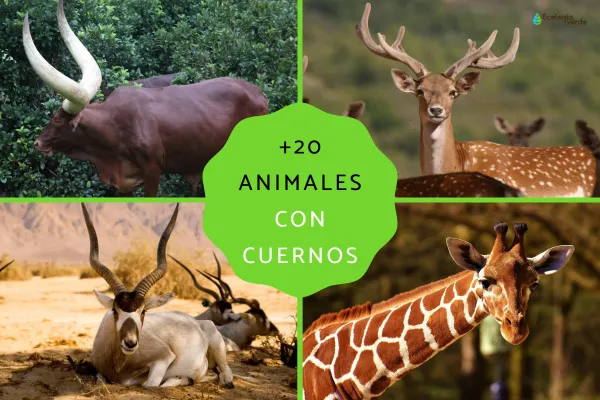
True horns (Bovidae style)
Bony core growing from the frontal bones, covered by a keratin sheath (often with fine hair/skin at the base). They do not shed annually; they persist and typically keep growing through life. Seen in Bovidae (cattle, sheep, goats, antelopes). In some species both sexes have horns; in others, females’ horns are shorter or absent.
Antlers (Cervidae)
Found in deer family. Entirely bone, covered in vascular “velvet” while growing, then shed and regrown each year. Usually only males carry antlers (notable exception: reindeer/caribou where both sexes are antlered). Antlers ≠ horns.
Common look-alikes (not true Bovidae horns)
Giraffe “ossicones”: ossified cartilage covered in skin and hair, fused to the skull; a distinct structure from horns/antlers.
Rhinoceros “horn”: compacted keratin fibers without a bony core—structurally unlike bovid horns.
“Horns” in reptiles (e.g., some chameleons, horned lizards): keratin/dermal projections, not Bovidae horns.
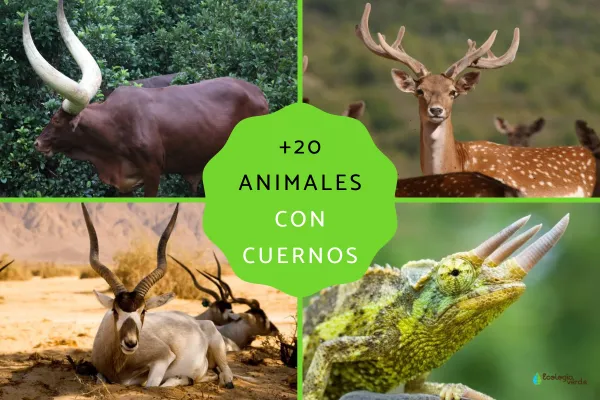
Ankole–Watusi (Bos taurus africanus)
Famous for enormous, hollow, blood-vessel-rich horns—single horns can exceed 1.5 m and weigh ~50 kg. Spectacular for display and heat dissipation.
Greater kudu (Tragelaphus strepsiceros)
Males sport elegant V-shaped spiral horns with 2–3 full twists, reaching ~1.25 m. Employed in display and wrestling.
Addax / white-antelope (Addax nasomaculatus)
Desert specialist of the Sahara; both sexes have long spiraled horns with clear ringed ridges.
Scimitar-horned oryx (Oryx dammah)
Long horns sweep back like a scimitar. Herd-living in arid and semi-arid plains.
Sable antelope (Hippotragus niger)
Deeply recurved, sabre-like horns—especially long in males. Will lunge forward horn-first at predators.
Grant’s gazelle (Nanger granti)
Slender, symmetrical, ringed horns (longer in males). A hallmark of East African savannas.
Tsessebe / topi complex (Damaliscus lunatus)
Both sexes horned, sporting short, open spirals; among the fastest antelopes.
Jackson’s chameleon (Trioceros jacksonii) — reptile note
Males often carry three horn-like projections (keratin/dermal), not true Bovidae horns; used in male–male posturing.
Giraffe (Giraffa spp.) “ossicones” — look-alike
Ossicones are skin-covered, ossified cartilage; commonly mistaken for horns but anatomically different.
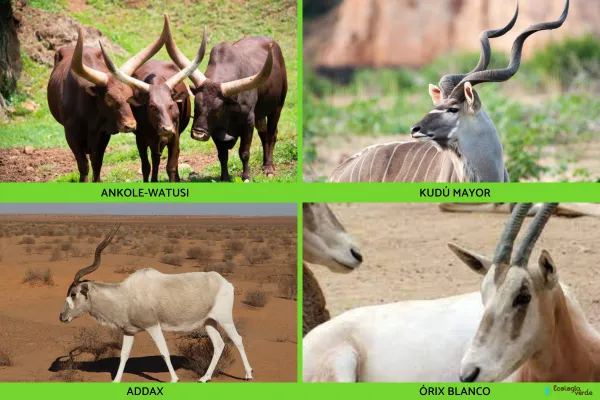
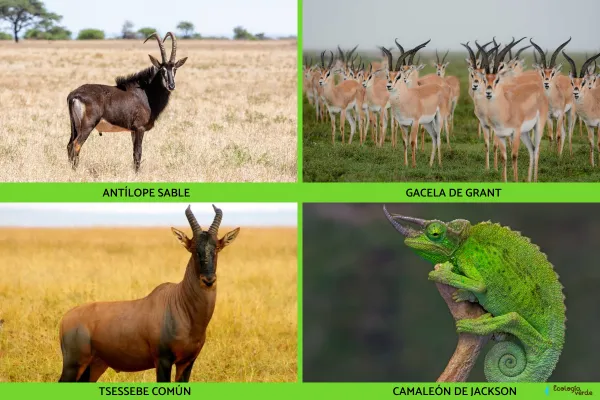
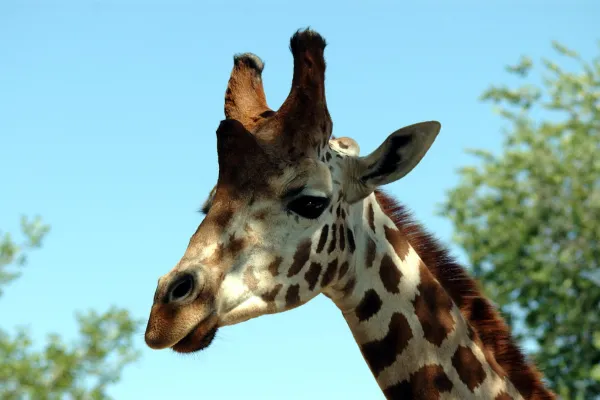
European mouflon (Ovis orientalis musimon)
Rams have impressive inward-curling horns used in ramming contests; mountain and hill country resident.
European bison (Bison bonasus)
One of Europe’s largest land mammals. Both sexes horned; horns are short, thick, and upcurved.
Chamois (Rupicapra rupicapra)
Short, vertical horns that hook sharply backward into a “fish-hook” tip—perfectly adapted to alpine life.
Alpine ibex (Capra ibex)
Massive, back-curving horns with pronounced transverse ridges; an iconic cliff-climber of the Alps.

Water buffalo (Bubalus bubalis)
Flattened, widely splayed horns that sweep back; tip-to-tip spans can approach ~1.2 m.
Gaur (Bos gaurus)
Stout horns with black tips, arcing upward; a colossal forest bovid of South and Southeast Asia.
Zebu / indicine cattle (Bos indicus or Bos taurus indicus)
Recognizable by a hump, drooping ears, and short horns; highly heat-tolerant domestic stock.
Nilgai / blue bull (Boselaphus tragocamelus)
Males only carry short, straight horns (about 15–24 cm). Common in India’s dry forests and scrub.
Saola (Pseudoryx nghetinhensis)
The elusive “Asian unicorn” of Vietnam–Laos mountains; both sexes bear slender, near-straight horns. Critically endangered.
Kouprey (Bos sauveli)
A mysterious forest wild bovine (Cambodia region). Males have spiraled horns; females carry longer, forward-curving horns. Wild status uncertain/possibly extinct.
(Wild) yak (Bos mutus) / domestic yak (Bos grunniens)
High-cold specialist with long horns that rise then cant inward; dense coat, superb cold and hypoxia tolerance.

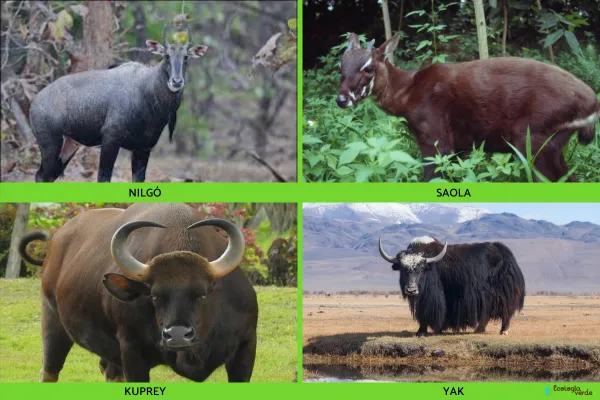
Do horns fall off and regrow like antlers?
Generally no. Bovid horns persist; if broken, the bony core is damaged and does not regrow like antlers. (Rhino “horns,” being keratin, can regrow length after trimming—but dehorning is not a simple or risk-free anti-poaching solution.)
Why do some females have horns, too?
In many bovids both sexes are horned (e.g., European bison, several antelopes). Presence/size relates to ecology and behavior (predation risk, social competition, territoriality).
Are horns only for fighting?
Not at all. Besides combat and deterrence, horns can aid display/species recognition, thermoregulation (large, vascularized horns), and bush-clearing while moving.
Use card layouts with: a profile photo + horn close-up, and a short fact strip: Horn shape (spiral/scimitar/straight), Who’s horned (♂ only / ♀♀ too), Habitat/Range, IUCN status.
Add a small “Don’t confuse…” graphic: Horns vs. Antlers vs. Ossicones vs. Rhino horn.
Make a mobile-friendly accordion so users tap to reveal “ID keys, distribution, horn use, conservation.”
Africa: Ankole–Watusi (Bos taurus africanus) / Greater kudu (Tragelaphus strepsiceros) / Addax (Addax nasomaculatus) / Scimitar-horned oryx (Oryx dammah) / Sable antelope (Hippotragus niger) / Grant’s gazelle (Nanger granti) / Tsessebe (Damaliscus lunatus) / Jackson’s chameleon (Trioceros jacksonii) / (note) Giraffe ossicones
Europe: Mouflon (Ovis orientalis musimon) / European bison (Bison bonasus) / Chamois (Rupicapra rupicapra) / Alpine ibex (Capra ibex)
Asia: Water buffalo (Bubalus bubalis) / Gaur (Bos gaurus) / Zebu (Bos indicus or Bos taurus indicus) / Nilgai (Boselaphus tragocamelus) / Saola (Pseudoryx nghetinhensis) / Kouprey (Bos sauveli) / Yak (Bos mutus)
Want to expand this topic on your site? Consider linking to:
Vertebrates: classification & key traits
Why deer antlers regrow annually (and how velvet works)
Giraffe ossicones vs. horns vs. antlers: a visual explainer
Bibliography
C. Urroz (2006). Elements of Animal Anatomy and Physiology. Editorial Universidad Estatal a Distancia, 2: 85-90.
C. Grigson (1991). An African Origin for African Cattle?. African Archaeological Review, 9: 119-144.
L. Harrison Matthews (1977). The Life of Mammals. Ediciones Destino. pp. 710-711
V. Hanak & V. Mazak (1990). Encyclopedia of Animals, Mammals of the World. Madrid, Spain: Susaeta. p. 208.
animal tags: horned animals
We created this article in conjunction with AI technology, then made sure it was fact-checked and edited by a Animals Top editor.